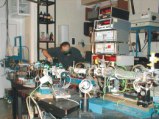|
THE INSTITUTE OF PHYSICS OF THE POLISH ACADEMY OF SCIENCES is one of the largest and most reputable scientific institutions in Poland. Currently, the Institute employs about 350 staff members of whom 250 are directly involved in the research activity of the Institute. Among them there are 30 full professors, 38 associate professors, 92 researchers with the Doctor's degree, 80 technical staff, and 64 PhD students.
International scientific activity of the Institute is very lively. Apart from human mobility programs and joint research projects, some spectacular research achievements must by highlighted. These are several unique spectroscopic techniques, developed within a framework of scientific cooperation, for example:
- Laplace Transform DLTS (Deep Level Transient Spectroscopy) and DLTS under uniaxial strain allowing identification of local atomic environment and symmetry of deep centres. These methods, unique on the world scale, were proposed and developed by Prof. L. Dobaczewski in co-operation with UMIST (University of Manchester Institute of Science and Technology, UK).
- Rotational spectroscopy of molecules and of weakly bound intermolecular complexes in supersonic expansion applied, among others, to studies of molecular systems which are present in the Earth atmosphere and thus are of environmental importance. This unique technique was developed by Assoc. Prof. Z. Kisiel and extensively used in co-operation with research groups from University of Exeter, United Kingdom, University of Bologna, Italy, and several other EU countries.
- ESR under pressure for studies of solid state as well as biological systems, namely biologically active molecules and complex macromolecules such as proteins. This experimental technique was developed by Dr. A. Sienkiewicz, in co-operation with the SUNY University at Albany, NY, USA, and EPFL, Lausanne, Switzerland.
- Polarisation labelling spectroscopy of diatomic molecules, that provides the data for precise determination of molecular potentials needed e.g. to study interactions in Bose-Einstein condensates. This unique experimental technique was developed by Assoc. Prof. W. Jastrzębski in collaboration with the Physics Department of the Warsaw University.
The Institute cooperates with numerous international institutions and university departments in most of the countries in Europe. The list includes Austria, Belgium, Bulgaria, Czech Republic, France, Spain, the Netherlands, Israel, Germany, Greece, Rumania, Slovakia, Sweden, Switzerland, Hungary, United Kingdom, Italy, Russia, Ukraine, and other independent states of the former Soviet Union. There are connections with American and Japanese institutions which help to keep abreast of the developments in physics and technology.
Over 100 joint research projects are run at the Institute in cooperation with foreign centres. Nearly 50% of them have been included into international agreements at government level between the State Committee for Scientific Research and equivalent committees or ministries of other countries. There are also over 50 research projects included into bilateral agreements between the Institute and partner institutes from abroad.
Currently 14 international projects financed from abroad, including 11 projects financed by EU within the Framework Programs, in particular - three Centres of Excellence: CELDIS, ASPECT and CEPHEUS are run in the Institute.
back to top |
|





 Contact persons
Contact persons